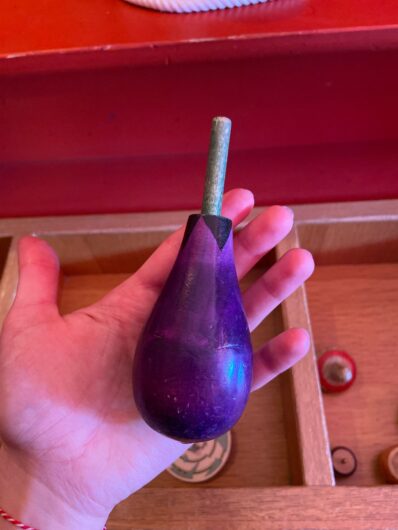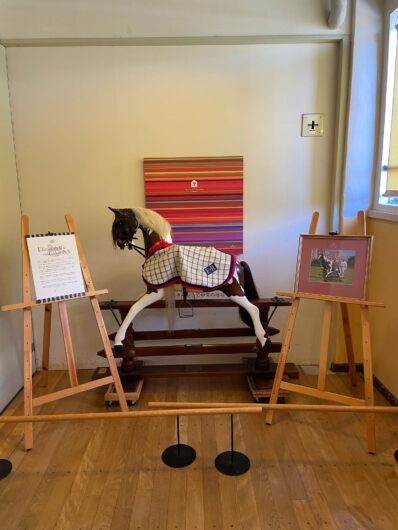In search of the Kamishibai; our travelling toy investigator Chiara discovers the Japanese Picture Show Story in Kyoto via Tokyo, Takayama and a Teddy Bear Eco Village Posted on
The History of Objects
A glimpse of Japanese culture through the stories behind its toys (Part One)
A month ago I left my role as dragon guarding the Pollock’s tower for a couple of weeks of travels around Japan. Little did I know, the toys decided to follow me…
Always bewitched by the secret history treasured in objects, I discovered innumerable little spots rich in stories and ended up learning a little bit more about the past and present of this country and its people. Let me try to retrace my steps by introducing you to the new friends I made…
- Stop one: Tokyo Toy Museum
After a couple of days spent exploring the buzzing streets of central Tokyo, I decided to slow down and catch my breath by adventuring into a different part of the metropolis to visit the Tokyo Toy Museum. Hidden away in a quiet, residential neighbourhood in the West side of the city, the museum takes over an ex primary school building very reminiscent of the one I attended many moons ago in Italy, which leads me to guess… 1950s? 60s? Either way, the wooden staircases and small corridors warmed up by the morning sunshine brought me back in time as I strolled through the classrooms-turned-galleries. Limited English signage and a storm of wild little creatures enjoying the extremely child-friendly facilities led me to increase my pace, though still enjoying the displays and overall ambiance.
Some collection highlights included an adorable hippo soft toy (somehow connected to London’s Design Centre), a variety of funky matrioshka doll (even a Paddington one!) and a selection of different types of spinning tops (with plenty of fruit and veggie shaped ones – my favourites…). Japan is known for its spinning tops (or koma), each one reflecting the character of the region it comes from – the zuguri-goma, for example, turns well on the snow of the Northern Tōhoku region; the noise-making bamboo takenari-goma resembles an ancient top from the Kinki region; the daikichi or fortune-telling top is typical of the Tottori Prefecture and probably originates as part of religious or spiritual rituals, spinning tops potentially mirroring the human lifecycle by spinning, stabilising themselves, losing balance and falling.

Japan is famous for it’s spinning tops.
Lastly, my visit ended with a glimpse at a Tinker Bell rocking horse donated to the museum by Queen Elizabeth II. The toy is fully handmade in England and meant to perfectly recreate the sovereign’s beloved childhood rocking horse.

Tinker Bell Rocking Horse donated to the Tokyo Toy Museum by Queen Elizabeth 2nd
- Stop two: Takayama Shōwa-kan Museum
During my time in Takayama, one of the best-preserved examples of an Edo period town, I stumbled upon a building definitely standing out from the rest. With its eye-catching posters and signs dotted all over its façade, the Takayama Shōwa-kan Museum instantly drew me in and transported me into another world… Reconstructing a town from the time, this not-so-hidden gem is a treasure trove of 1950s-80s Japanese paraphernalia and culture, featuring bars, restaurants, a barber shop, a record store, a school and, of course, a toyshop! The Shōwa period is the stretch of time going from the 1920s to the 1980s and is usually further divided into a pre and a post war phase. In this case, the museum acts as a time capsule of post-WWII Japan – a country occupied by a foreign power (USA) for the first and only time in its history and witnessing a unique economic boom resulting in the mass production of an unprecedented amount of goods (a lot of which of obvious American influence). Needless to say, such a Technicolor paradise made me lose my mind… Among my favourites: flat paper and vinyl dollhouses; a set of colourful, plastic needles to assemble on a TV-shaped board to make up the preferred image; wooden blocks coming together into a very tasty-looking apple; paper hanging decorations and lanterns in all shapes and forms; and, of course, tons of videogames from the good old days!
- Stop three: Hida Takayama Teddy Bear Eco Village
Another toy-related stop while in Takayama was meant to be the local Teddy Bear Eco Village, apparently the country’s first example of teddy bear museum showcasing the stuffed toys as if in their natural habitat. After a half an hour walk uphill, I found out the spot was closed, but didn’t despair – I had a look at their shop, selling a range of teddys of all types (Steiff, Merrythoughts and Charlie Bears included), and opted for a quick pit-stop. Scrolling through my photos, I ended up reading some bits and bobs about a few, interesting toys I had met up until that point…
One of Takayama’s symbols is the sarubobo, a traditional amulet in the shape of a red, faceless doll. Originally made by grandmothers for their daughters to wish them a healthy and fertile marriage, and for their granddaughters to play with, nowadays they have become a popular lucky charm. The reason for their facelessness lies in the fact that sarubobo were originally made by relatives with leftover cloth, so absolute accuracy wasn’t needed. Another idea is that the absence of a face allows the owner to imagine an expression on the doll and therefore resonate more closely with it.
While here, I also had the pleasure of witnessing the celebration of Hinamatsuri or Girls’ Day/Dolls’ Day. On the 3rd March and for the rest of the month, families with daughters arrange their hina-ningyo in the home or by a window for people to enjoy. These are collections of dolls sat on a red platform, usually on five or four levels. The dolls can be as simple as pictures or folded paper figures or as elaborate as three-dimensional carved/sculpted ones. The entire set is called hinakazari and is often handed down from generation to generation as a family heirloom, some of the most complex dolls being very expensive. As part of Hinamatsuri, nagashi-bina (doll-floating) ceremonies are held around the country – paper/straw dolls are made and sent on a boat down a river, carrying one’s impurities and sins with them.
Finally, various daruma dolls kept appearing here and there during my adventures. These are hollow, round, traditional Japanese toys modelled after Bodhidharma (the founder of Zen Buddhism). They have become popular lucky charms symbolising perseverance and encouragement. When purchased, the figure’s eyes are both white: the owner selects a goal/wish and paints the left eye; once the goal is achieved, the right is filled in, too. Usually made out of hollow paper-mâché with a weight at the bottom, these dolls always return to an upright position whenever tilted (roly-poly or okiagen), embodying the possibility to overcome adversity, recovering and having success.
- Stop four: Kyoto International Manga Museum
While researching Kyoto, I read about the International Manga Museum and, though not a particularly dedicated reader of the genre, instantly became quite intrigued with it. Upon visiting it, I realised the spot is also housed in an ex-primary school, this time an early 1900s one. The high-reputation institution shut down in the 1990s due to a significant decrease in natality rates as well as an increase in families moving outside of the city. Wishing to carry on the school’s original educational mission, the building was turned in a museum in 2006, specifically one dedicated to the archiving and preserving of manga, anime and videogames as valuable Japanese and international cultural properties. As I was enjoying the numerous galleries dedicated to both the history of the ex-school and manga, I read a sign mentioning an art form called kamishibai (picture-story show). Among others, manga seems to have found its origins as an evolution of this post-war Shōwa period type of street performance. An artist would tell a story to (generally) a crowd of children by using a series of pictures made to slide through a small, wooden theatre/television structure. An example of kamishibai was being performed at the museum at that very moment, so I stopped by and enjoyed the hilarious show. Though closer to the concept of television perhaps, the art form couldn’t help but remind me of Pollock’s very own toy theatres and their traditional performances dating back to the 1800s! Could Kamishibai be considered an early example of toy TV?
As we’ve made it halfway-through my trip, it’s now time for a well-deserved tea break! But stay tuned as my tales will continue to unfold very soon…
Chiara Scoglio May 2025
